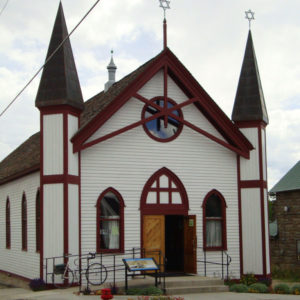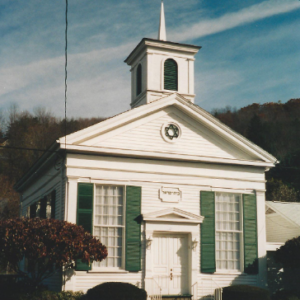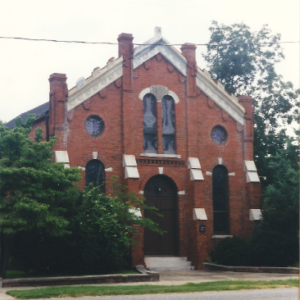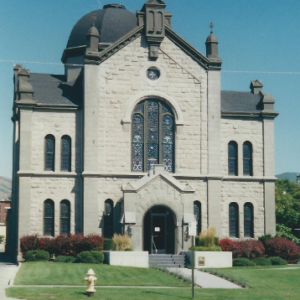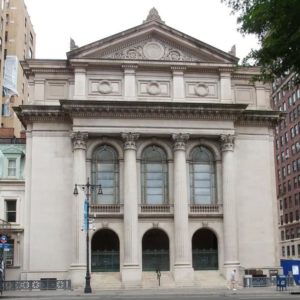This article – the third in a series – will document buildings which were originally erected as synagogues in the United States in the eighteenth and nineteenth centuries and are still standing today. Calling attention to these structures focuses on the importance of maintaining and preserving them, either as houses of worship or alternative uses.
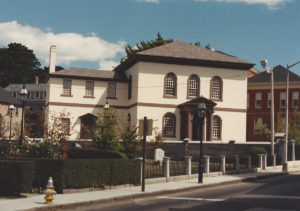
The first article in this series appeared in American Jewish History in March 1986 (Vol. 75, No. 3). It identified for the first time fifty-two (52) extant eighteenth- and nineteenth-century synagogue buildings in the United States. I located many of these structures by searching downtown districts throughout the country. Touring former Jewish neighborhoods sometimes led to the sudden and exciting discovery of a former synagogue. Architectural styles, along with remnants of Judaic ornamentation (Stars of David, tablets, Hebrew cornerstones, etc.), assisted in identifying and dating the building.
Through additional urban exploring, research and input from American Jewish History readers around the country, the second article in this series, published in the March 1996 American Jewish History (Vol. 84, No. 1) enumerated ninety-six (96) extant purpose-built US eighteenth- and nineteenth-century synagogue structures including the fifty-two (52) noted above.
Architects, historians, urban planners and community members have used this information for a variety of purposes. For example, many Jewish congregations are proud to worship in the oldest extant synagogues in the country. By 2018, at least thirty separate Wikipedia entries footnote the March 1996 American Jewish History article, including individual entries for such well-known structures as Touro Synagogue (Newport – fig. 1), Plum Street Synagogue (Cincinnati) and Central Synagogue (NYC).
As of today, the total number of all known pre-1900 synagogue buildings is ninety-seven (97). This includes thirteen additional synagogues discovered since 1996, offset by twelve subtractions from demolitions and other factors described below. Each entry in Table 1 includes the address of the structure, its architectural style, the name of the original congregation, whether the original congregation still uses its building, and if not, the current use. You may access Table 1 below.
Table 1: Pre-1900 Buildings Erected as Synagogues and Still Standing
| DATE | CITY & ADDRESS | STATE | ORIGINAL CONGREGATION | CURRENT USE | ARCHITECTURE |
|---|---|---|---|---|---|
| 1759-63 | NEWPORT 85 Touro St. |
RI | Jeshuat Israel (O) (Touro Synagogue) |
Same | Georgian |
| 1840-41 | CHARLESTON 86-90 Hasell St. |
SC | K.K. Beth Elohim (R) | Same | Greek Revival |
| 1845 | BALTIMORE 11 Lloyd St. |
MD | Baltimore Hebrew Cong. (R) (Lloyd Street Synagogue) |
Museum | Greek Revival |
| 1849-50 | NEW YORK CITY 172 Norfolk St. |
NY | Anshe Chesed (R) (Angel Orensanz Center) |
Event venue, holiday services |
Gothic |
| 1853 | NEW YORK CITY 8 Clinton St. |
NY | Rodeph Sholom (R) | Chasam Sopher (O) | Romanesque |
| 1856 | HONESDALE 7th & Court Sts. |
PA | Beth Israel (R) | Same | Greek Revival |
| 1860 | CINCINNATI Ruth Lyons Lane |
OH | Sherith Israel (O) | Condos | Vernacular |
| 1860-65 | NEW ORLEANS 709 Jackson Ave. |
LA | Shaarei Tefiloh (R) | Condos | Eclectic |
| 1863 | MADISON Gorham & Butler Sts.* |
WI | Shaarai Shomayim (R) | Community center | Romanesque |
| 1865-66 | CINCINNATI 8th & Plum Sts. |
OH | K.K. B’nai Yeshurun (R) (Isaac M. Wise Temple) (Plum Street Synagogue) |
Same | Moorish Gothic |
| 1865-67 | CUMBERLAND 107 Union St. |
MD | B’er Chayim (R) | Same | Greek Revival |
| 1867 | LAFAYETTE 17 S. 7th St. |
IN | Temple Israel (R) | Church, social services | Romanesque |
| c. 1868 | HUDSON 530 Columbia St. |
NY | Ohav Sholem (disbanded) | House | Eclectic |
| 1869 | AUGUSTA 525 Telfair St. |
GA | B’nai Israel (R) | Museum | Greek Revival |
| 1869-70 | QUINCY 427 N. 9th St. |
IL | B’nai Sholom (R) | Closed in 2019 | Moorish |
| 1870 | GALVESTON 816 22nd St. |
TX | B’nai Israel (R) Re-built c.1890 |
Masonic temple | Moorish Gothic |
| 1870 | TROY 167 3rd St. |
NY | Temple Berith Sholom (R) | Same | Romanesque |
| 1870-72 | NEW YORK CITY 123 E. 55th St. |
NY | Ahavath Chesed (R) (Central Synagogue) |
Same | Moorish |
| 1872 | DONALDSONVILLE 301 Railroad Ave. |
LA | Bikur Cholim (disbanded) | Hardware store | Vernacular |
| 1875-76 | HARTFORD 21 Charter Oak Ave. |
CT | Temple Beth Israel (R) (Charter Oak Cultural Ctr.) |
Cultural center | Eclectic |
| 1875-76 | WILMINGTON 1 S. 4th St. |
NC | Temple of Israel (R) | Same | Moorish |
| 1876 | BALTIMORE 27-35 Lloyd St. |
MD | Chizuk Amuno (C) | B’nai Israel (O); museum |
Victorian Gothic/ eclectic |
| 1876 | BROOKLYN 274 Keap St. |
NY | Beth Elohim (R) | Hebrew school | Victorian Gothic |
| 1876 | WASHINGTON 3rd and F |
DC | Adas Israel (C) | Completed second move | Romanesque |
| 1876-78 | SAVANNAH 20 Gordon St. |
GA | Mickve Israel (R) | Same | Gothic |
| 1877 | OWENSBORO 429 Daviess St. |
KY | Temple Adath Israel (R) | Same | Moorish Gothic |
| 1881 | GRAND RAPIDS 72 Ransom Ave. NE |
MI | Temple Emanuel (R) | Anti-abortion organization | Vernacular as modified |
| 1882 | BROWNSVILLE 171 N. Washington Ave. |
TN | Adas Israel (R) | Occasional use | Gothic |
| 1882 | CHARLOTTESVILLE 301 E. Jefferson St.* |
VA | Beth Israel (R) | Same | Victorian Gothic |
| 1882 | DENVER 24th & Curtis Sts. |
CO | Temple Emanuel (R) | Incubator offices | Victorian |
| 1883 | HOBOKEN 637 Garden St. |
NJ | Adas Emuno (R) | Church | Gothic/Romanesque |
| 1883 | JEFFERSON CITY 318 Monroe St. |
MO | Temple Beth El (R) | Same | Gothic |
| 1883-84 | APPLETON 320 N. Durkee St. |
WI | Temple Zion (disbanded) | Organ shop | Victorian Gothic |
| 1884 | NEWARK 32 Prince St. |
NJ | Oheb Shalom (C) (Prince Street Synagogue) |
Environmental center |
Moorish |
| 1884 | LEADVILLE 201 W. 4th St. |
CO | Temple Israel (disbanded) | Museum | Victorian Gothic |
| 1884-85 | BOSTON Columbus & Northampton |
MA | Temple Israel (R) | Church | Victorian Romanesque |
| 1885 | BURLINGTON 168 Archibald St. |
VT | Ohavi Zedek (C) | Ahavath Gerim (O) | Gothic |
| 1885-86 | TRAVERSE CITY 311 Beth El Way |
MI | Beth El (R) | Beth Shalom | Vernacular |
| 1886 | GOLDSBORO 314 N. James St. |
NC | Oheb Sholom (R) | Closed; food pantry in rear | Romanesque |
| 1886 | PHILADELPHIA 7th St. & C.B. Moore Ave. |
PA | Adath Jeshurun (C) | Church | Moorish |
| 1886 | ROCHESTER 30 Leopold St. |
NY | Beth Israel (C) (Leopold Street Shul) |
Black Hebrew cong. | Romanesque/eclectic |
| 1886-87 | NEW YORK CITY 12 Eldridge St. |
NY | Khal Adas Jeshurun (O) (Eldridge St. Synagogue) |
Same, museum | Moorish |
| 1887-89 | ALBANY Lancaster & S. Swan Sts. |
NY | Temple Beth Emeth (R) | Church | Richardsonian Romanesque |
| 1888 | OCALA 729 NE 2nd St. |
FL | United Hebrews of Ocala (R) | Church | Eclectic |
| 1888 | SAN LEANDRO 642 Dolores Ave.* |
CA | Temple Beth Sholom (C) | Same | Vernacular |
| 1888-89 | TRINIDAD 407 S. Maple St. |
CO | Congregation Aaron (R) | Occasional Use | Moorish/eclectic |
| 1889 | LAFAYETTE 603 Lee Ave. |
LA | Rodeph Shalom (R) | Same | Vernacular as modified |
| 1889 | ALLIANCE Gershel & Schiff Aves. |
NJ | Tifereth Israel (disbanded) (Sharis Israel) |
Occasional use | Vernacular |
| 1889 | BLOOMINGTON 315 N. Prairie St. |
IL | Moses Montefiore Temple (R) | Residence | Moorish |
| 1889 | LIGONIER 503 S. Main St. |
IN | Ahavas Sholom (disbanded) | Residence | Victorian Gothic |
| 1889 | SAN DIEGO Juan & Harney Sts.* |
CA | Temple Beth Israel (R) | Community center; museum | Romanesque/eclectic |
| 1889-90 | NEW YORK CITY 163 E. 67th St. |
NY | Zichron Ephraim (O) (Park East Synagogue) |
Same | Moorish |
| 1889-90 | BRUNSWICK 1326 Egmont St. |
GA | Beth Tefilloh (R) | Same | Moorish |
| 1890-91 | NEWBURGH 119 South St. |
NY | Temple Beth Jacob (R) | Church | Eclectic |
| 1890-91 | BALTIMORE 1914 Madison Ave. |
MD | Baltimore Hebrew Cong. (R) | Church | Eclectic |
| 1890-91 | CHICAGO 3301 S. Indiana Ave. |
IL | Kehilath Anshe Ma’ariv (R) only exterior walls remain | Future gospel music museum | Chicago School |
| 1890-91 | SALT LAKE CITY 249 S. Fourth East |
UT | B’nai Israel (C/R) | Interior design office | Romanesque |
| 1890-91 | HELENA 515 N. Ewing St. |
MT | Temple Emanu-El (disbanded) |
Diocese office | Moorish/eclectic |
| 1891 | STATEN ISLAND 199 Victory Blvd. |
NY | B’nai Jeshurun (C) | Church | Eclectic |
| 1891-92 | HENDERSON Center & N. Alves Sts. |
KY | Adas Israel (disbanded) | Church | Victorian |
| 1891-92 | PORT GIBSON 706 Church St. |
MS | Temple Gemiluth Chassed (R) | Museum | Moorish/eclectic |
| 1891-92 | STATESVILLE 206 N. Kelly St. |
NC | Emanuel (C) | Same | Romanesque |
| 1891-92 | SCHENECTADY 18 N. College St. |
NY | Shaarai Shamayim (R) | Church | Romanesque/eclectic |
| 1892 | KINGSTON 50 Abeel St. |
NY | Temple Emanu-El (R) | Apartments | Romanesque/eclectic |
| 1892-93 | BALTIMORE 1307 Eutaw Pl. |
MD | Oheb Shalom (R) | Masonic temple | Byzantine/eclectic |
| 1893 | ANNISTON 1301 Quintard Ave. |
AL | Temple Beth-El (R) | Same | Eclectic |
| 1893 | BRENHAM Austin JCC campus * |
TX | B’nai Abraham (O) moved to Austin in 2014-15 |
Tiferet Israel (O) | Gothic/vernacular |
| 1893-94 | CLEVELAND E. 55th & Central Sts. |
OH | Tifereth Israel (R) | Church | Richardsonian Romanesque |
| 1894 | CENTERVILLE E. Terry & S. 15th Sts. |
IA | B’nai Israel (disbanded) | Church | Gothic/vernacular |
| 1894 | NEW YORK CITY 160 W. 82nd St. |
NY | Shaaray Tefila (R) | Church | Moorish/eclectic |
| 1894 | ALLENTOWN 625 N. 2nd St. |
PA | Agudas Achim (O) | Vacant | Gothic/vernacular |
| 1895 | BALTIMORE 1501 McCulloh St. |
MD | Chizuk Amuno (C) | Church | Classical/Romanesque |
| 1895 | SAN FRANCISCO 1881 Bush St. |
CA | Ohabai Shalome (disbanded) (Bush Street Temple) |
Assisted Living | Eclectic |
| 1895 | BROOKLYN 98 Scholes St. |
NY | Ahavath Scholom | Church | Romanesque |
| 1895-96 | BOISE 11 N. Latah St.* |
ID | Ahavath Beth Israel (R) moved in 2003 |
Same | Romanesque/Moorish |
| 1895-96 | LANCASTER 508 N. Duke St. |
PA | Shaarai Shomayim (R) | Same | Classical/eclectic |
| 1896 | BROOKHAVEN Chickasaw & S. Church |
MS | B’nai Shalom | Museum | Eclectic |
| 1896 | WOODBINE 614 Washington Ave. |
NJ | Woodbine Brotherhood (disbanded) |
Museum | Vernacular |
| 1896 | ALTOONA 1433 13th Ave. |
PA | Mountain City Hebrew Reform Cong. (R) |
Church | Moorish |
| 1896-97 | NEW HAVEN Orange & Audubon Sts. |
CT | Mishkan Israel (R) | Arts center | Eclectic |
| 1896-97 | NEW YORK CITY 8 W. 70th St. |
NY | Shearith Israel (O) (Spanish & Portuguese) |
Same | Classical |
| 1897 | PEEKSKILL 813 Main St. |
NY | First Hebrew Cong. (C, O) | Mosque | Gothic |
| 1897-98 | WASHINGTON 8th & I Sts., N.W. |
DC | Washington Hebrew Cong. (R) | Church | Romanesque/eclectic |
| 1898 | CHICAGO 44th St. & St. Lawrence |
IL | Temple Israel (R) | Church | Classical |
| 1898 | PEORIA 521 N.E. Monroe St. |
IL | Anshai Emeth (R) | Church | Gothic/eclectic |
| c. 1898 | ROSENHAYN 600 Garton Road |
NJ | Or Yisrael Cong. (disbanded) | Unused | Vernacular |
| 1898-99 | CHICAGO 45th St. & Vincennes Ave. |
IL | Temple Isaiah (R) | Church | Classical |
| 1898-99 | HUNTSVILLE 103 Lincoln St., S.E. |
AL | B’nai Sholom (R) | Same | Eclectic |
| 1898-99 | DENVER 1595 Pearl St. |
CO | Temple Emanuel (R) | Church | Moorish/eclectic |
| 1898-1900 | SAG HARBOR Elizabeth St. & Atlantic Ave. |
NY | Temple Mishcan Israel (C) | Temple Adas Israel (R) |
Vernacular |
| 1899 | BAY CITY 200 N. Van Buren St. |
MI | Shaarey Zedek (C) | Church | Classical |
| 1899-1900 | DANVILLE 127 Sutherlin Ave. |
VA | Temple Beth Sholom (R) | Same | Eclectic |
| 1899-1900 | SELMA 503 Broad St. |
AL | Mishkan Israel (R) | Occasional use; future museum | Romanesque/eclectic |
| 1899-1900 | CORSICANA 208 S. 15th St. |
TX | Temple Beth-El (C) | Community center, minyanim | Moorish |
| 1900 | NEW YORK CITY 23 W. 118th St. |
NY | Shaare Zedek (C) | Church | Moorish |
| 1900 | PUEBLO 1325 No. Grand Ave. |
CO | Temple Emanuel (R) | Same | Queen Anne |
| c. 1900 | NORMA Almond Rd. & Wallace St. |
NJ | Ahavas Achim (O) (Norma Brotherhood) |
Occasional use | Vernacular |
The dates for each entry generally signify the date of cornerstone and the date of dedication of the original synagogue. Asterisks (*) indicate buildings which have been physically moved to their current location. (O), (C), and (R) stand for Orthodox, Conservative, and Reform; they illustrate the present-day affiliation of the original congregation or its successor through merger. “Same” indicates that the original congregation still uses the building for worship services. With the exception of “Greek Revival”, architectural styles such as Romanesque Revival and Moorish Revival are abbreviated above by omitting the word “Revival”. Buildings which have been totally rebuilt and are no longer recognizable as former places of worship are not included.
The ninety-seven (97) extant synagogues are located in thirty-one states and the District of Columbia. Twenty are in New York State, with eleven of these in New York City. Three states (IL, MD and NJ) have six each, with five in Colorado and Pennsylvania and four or less in the other states.
What Has Changed Since 1996

Additions: Since 1996, the author has discovered thirteen additional extant pre-1900 synagogue buildings. These include structures in Cincinnati (Sherith Israel); New Orleans; Hudson, NY; Lafayette, Augusta, GA; LA; Ocala, FL; Brunswick, GA; Schenectady, NY; Allentown, PA; Centerville, IA; Brooklyn (Ahavath Scholom); Altoona, PA; and Peekskill, NY.
Subtractions: Unfortunately, the additions were offset by twelve subtractions. These include discovery of seven demolitions: Easton, PA (demolished in 2003 after fire damage); Cincinnati (K.K. Bene Israel); Placerville, CA; New York City (Or Zarua demolished by its Jewish congregation in 1999); Atlantic City (demolished by the city in 2013); Chicago (Anshe Emeth on Sedgwick St.); and Charleston, WV. Some of the demolitions were verified by Google Street View aerial maps, a welcome update in technology.
Other reasons for subtractions include the discoveries that: 1) The Las Vegas, NM synagogue and New York City’s Forsyth St. Synagogue were originally purpose built as churches; 2) Ahavath Sholom in Buffalo was actually constructed in 1901-03 (after the 1900 cut-off); 3) The synagogue in Demopolis, AL was newly built in the 1950s inside a much larger 1893 synagogue which was subsequently demolished; and 4) The synagogue in Alpena, Michigan started out as a residence that was moved to the site and remodeled into a synagogue.
Other Updates: Temple Israel in Leadville, CO (fig. 2) was restored in 2008 to its original appearance by replacing decorative elements previously removed while used as apartments. Kehilath Anshe Ma’ariv on Chicago’s South Side suffered significant damage from a building fire in 2006. Only the exterior walls remain of this Chicago School synagogue designed by prominent architects Dankmar Adler and Louis Sullivan.
Additionally, information on synagogue dates of construction, names and addresses was revised in 2018 and is updated annually as appropriate.
Physical Relocation of Synagogue Buildings
Over the years, synagogues in Madison, WI; Washington, DC; Charlottesville, VA (fig. 3); San Leandro, CA; and San Diego, CA, have been physically moved in order to save them from the wrecking ball. More recently, Temple Beth Israel in Boise, ID was moved in 2003 adjacent to the congregation’s newer building, and B’nai Abraham in Brenham, TX was moved across several counties to the Austin JCC campus in 2014-15.1
Worship and Adaptive Reuse
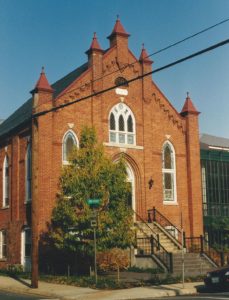
While many of the buildings originally constructed as synagogues are now used for other purposes, some remain as Jewish houses of worship. In over twenty different states, one or more nineteenth-century buildings are still utilized for Jewish services, as Table 1 indicates.
Adaptive reuse of a historic building is defined as implementing a new and/or additional use for a building originally designed for another purpose. Structures such as fire houses, train stations, courthouses, and religious edifices often find new uses. Nineteenth-century synagogues are no exception. For these buildings, the most popular reuse is as a house of worship for another religion. Other successful adaptive reuses of synagogue buildings include offices, museums, community/cultural centers, performing arts centers, and schools. Unusual uses in 2018 include offices for the Catholic Diocese of Helena, MT and those for an anti-abortion group in Grand Rapids, MI. As a building’s use is changed, the new owner can renovate it in such a way to preserve the structure’s major architectural features. Reuse of a historic synagogue no longer needed by its original congregation is much preferable to demolition.
Some congregations may look to the Talmud for guidance when vacating a synagogue. Mishnah Megillah 3:1 directs that congregations which sell a synagogue use the proceeds for an equivalent or holier purpose. Based on interpretations of this text, an Orthodox congregation may place restrictions on a buyer’s future use of its house of worship. For example, when the Jewish Historical Society of Maryland purchased Baltimore’s Lloyd Street Synagogue in 1963, it accepted a deed restriction that the building would not be used on Shabbat or Jewish festivals.2
Preservation Movement
An exciting development intensifying during the past twenty-five years has been various grassroots efforts to save synagogues threatened with demolition. Synagogues that have been saved from pending demolition include those in Baltimore, Corsicana, TX; Denver (fig. 4); Hartford; Newark, NJ (fig. 5); New York City; and Port Gibson, MS.
Awareness of these successful grassroots efforts to save nineteenth-century synagogues will hopefully spur other communities to mount similar efforts when historic Jewish infrastructure is threatened. Many of the buildings reflect architectural beauty and craftsmanship that would never be created today. Some of them provide a special historical element to a municipality’s original core downtown.

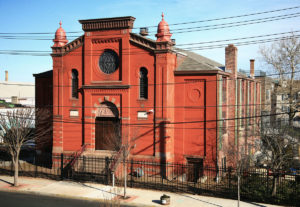
Architectural Styles
Table 1 includes the architectural styles for each synagogue entry. Often following trends in secular and ecclesiastical architecture, the look of US synagogues evolved over the decades of the nineteenth century.
The Touro Synagogue, the only extant eighteenth century entry, was designed in the Georgian style by noted colonial architect Peter Harrison. Both Beth Elohim (Charleston, SC) and the Baltimore Hebrew Congregation were constructed in the Greek Revival style, popular for houses of worship in the 1840s and early 1850s. Beth Israel in Honesdale, PA (fig. 6) is an example of this style. Romanesque Revival synagogues with round-arched windows became evident for several decades beginning in the 1850s as seen in Goldsboro, NC (fig. 7) and Salt Lake City (fig. 8), Gothic Revival and Victorian styles, like those illustrated in Leadville, CO (fig. 2) and Charlottesville, VA (fig. 3), became more common beginning in the 1870s and 1880s. (A sub-style of Romanesque Revival architecture is Rundbogenstil originating in Germany. Nineteenth-century synagogues in Boise, ID; Lafayette, IN; and Madison, WI are examples of this sub-style.)


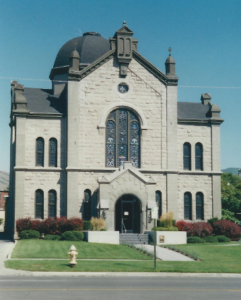
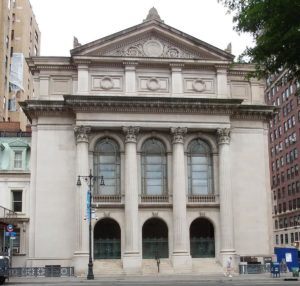
The Moorish Revival style was used heavily for synagogues but not in secular architecture from the 1860s to 1890s. Moorish synagogues often contained onion-shaped domes or minarets, horseshoe arches, and polychromatic decoration. One theory for their popularity is the nineteenth century revival of Jewish scholarly interest in the history of the Sephardic Diaspora, including its Golden Age in Spain and Northern Africa.3 Additionally, congregations built Moorish buildings in part to differentiate them from Victorian-style churches.4 Examples of Moorish synagogues are those in Denver (fig. 4) and Newark (fig. 5).
At the turn of the century, synagogue architecture returned to the American architectural mainstream with a heavy emphasis on the Classical Revival style. The change is attributable to the interest in classical design at the 1893 Columbian Exposition in Chicago and also to archaeological discoveries of Galilean synagogues built during Roman times.5 This style was adopted by New York City’s Shearith Israel (fig. 9).
The small number of remaining eighteenth- and nineteenth-century structures underscores the transitions that have taken place in Jewish life over the past 150 years. As Jews migrated out of small towns to large cities, and out of cities to suburbs, the religious spaces that they built have been purchased by new owners and used for new purposes. Historical preservationists, however, have built community support both within and outside the Jewish community in order to preserve these synagogues as emblems of the Jewish past.
Those interested in learning more about eighteenth- and nineteenth-century synagogues may review this list of sources. Please also see the below gallery for more in-depth information on the synagogue buildings featured here.
NOTES:
- Samuel D. Gruber, “In Texas, a Synagogue is Trucked to Its New City,” Tablet Magazine (New York City: Nextbook Inc., December, 2014).
- Earl Pruce, Synagogues, Temples and Congregations in Maryland: 1830-1990 (Baltimore: The Jewish Historical Society of Maryland, 1993), 84.
- Samuel D. Gruber, Synagogues (New York: MetroBooks – Friedman/Fairfax Publishers, 1999), 86-88.
- Geoffrey Wigoder, The Story of the Synagogue (San Francisco: Harper & Row, 1986), 174.
- Rachel Wischnitzer, Synagogue Architecture in the United States: History and Interpretation (Philadelphia: Jewish Publication Society of America, 1955), 91, 95-96.


